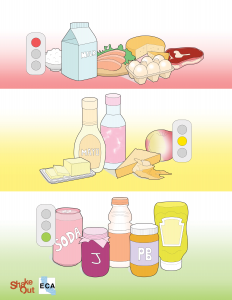The Seven Steps
Kitchen Food Safety
Protecting stored foods when the power goes out
- Keep refrigerator and freezer doors closed as much as possible. A full refrigerator will maintain safe temperatures for up to six hours. A full freezer will maintain safe temperatures for up to two days; a half-full freezer for one day. Discard at-risk refrigerated foods that are warmer than 45° Fahrenheit. If in doubt, throw it out.
- If you think the power will be out for several days, try to find some ice to pack inside the refrigerator and freezer. Remember to keep your raw foods separate from your ready-to-eat foods.
Foods to be concerned about
Foods are categorized into groups:
- Potentially hazardous foods are the most important. These include meats, fish, poultry, dairy products, eggs and egg products, soft cheeses, cooked beans, cooked rice, cooked potatoes, cooked pasta, custards, puddings, etc.
- Some foods may not be hazardous but the quality may be affected. These foods include salad dressings, mayonnaise, butter, margarine, produce, hard cheeses, etc.
- Some foods are safe. These are carbonated beverages, unopened bottled juices, ketchup, mustard, relishes, jams, peanut butter, barbecue sauces, etc.
When do I save and when do I throw out food?
- Refrigerated foods should be safe as long as the power is out no more than a few hours and the doors have been kept closed. Potentially hazardous foods should be discarded if they warm up above 45°F.
- Frozen foods which are still frozen are not a problem. If potentially hazardous foods are thawed but still have ice crystals, you should use them as soon as possible.
- If potentially hazardous foods are thawed and warmer than 45°F, you should discard them.
How do I know if the food is unsafe to eat?
- You cannot rely upon appearance or odor. Never taste food to determine its safety.
- Some foods may look and smell fine, but if they’ve been warm too long, food poisoning bacteria may have grown enough to make you sick.
- If possible, use a thermometer to check the temperature of the foods. If potentially hazardous foods are colder than 45°F, they are safe.
What happens when the power goes back on?
Allow time for refrigerators to reach the proper temperature of lower than 45°F before restocking. Start with all fresh foods.





